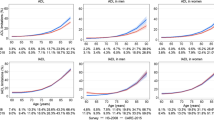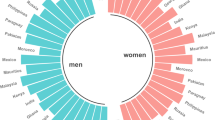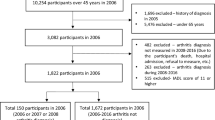Abstract
Background
While older adults with pre-obesity and Class I obesity have similar or lower mortality risk versus those with normal weight, a heavier body mass index (BMI) may not translate into more healthy life years. Utilizing longitudinal data on 3452 older (≥60 years) Singaporeans, we assessed the association between BMI and years of remaining life overall with and without limitation in physical function and in activities of daily living (ADLs).
Methods
Difficulty in any of nine tasks involving upper or lower extremities was considered as limitation in physical function, and health-related difficulty in any basic ADL or instrumental ADL as limitation in ADLs. We utilized multistate life tables, including BMI as a time-varying covariate.
Results
At age 60, life expectancy (LE) was similar for those with normal weight, pre-obesity and obesity. However, those with obesity, versus normal weight, had 6.3 [95% confidence interval: 3.4–9.2] more years with limitation in physical function and 4.9 [3.4–6.5] less years without limitation in physical function. Those with pre-obesity, versus normal weight, also had 3.7 [1.9–5.3] more years with limitation in physical function. The same pattern across BMI categories was observed for years of life with and without limitation in ADLs. In stratified analyses, similar associations of BMI with years of life with and without limitation in physical function and in ADLs were observed across gender, ethnicity, and educational status.
Conclusions
The increasing global prevalence of obesity may result in an increase in years of life with limitation in physical function and in ADLs at older ages. Older adults, their families and healthcare systems should be cognizant of this issue.
This is a preview of subscription content, access via your institution
Access options
Subscribe to this journal
Receive 12 print issues and online access
$259.00 per year
only $21.58 per issue
Buy this article
- Purchase on Springer Link
- Instant access to full article PDF
Prices may be subject to local taxes which are calculated during checkout
Similar content being viewed by others
Code availability
The dataset and IMaCh code can be requested from the corresponding author.
References
Abarca-Gómez L, Abdeen ZA, Hamid ZA, Abu-Rmeileh NM, Acosta-Cazares B, Acuin C, et al. Worldwide trends in body-mass index, underweight, overweight, and obesity from 1975 to 2016: a pooled analysis of 2416 population-based measurement studies in 128·9 million children, adolescents, and adults. Lancet. 2017;390:2627–42.
United Nations. Ageing. 2016. http://www.un.org/en/sections/issues-depth/ageing/index.html. Accessed 02 May 2018.
Flegal KM, Kit BK, Orpana H, Graubard BI. Association of all-cause mortality with overweight and obesity using standard body mass index categories: a systematic review and meta-analysis. JAMA. 2013;309:71–82.
DeCaria JE, Sharp C, Petrella RJ. Scoping review report: obesity in older adults. Int J Obes. 2012;36:1141–50.
Diehr P, O’Meara ES, Fitzpatrick A, Newman AB, Kuller L, Burke G. Weight, mortality, years of healthy life, and active life expectancy in older adults. J Am Geriatr Soc. 2008;56:76–83.
Reynolds SL, McIlvane JM. The impact of obesity and arthritis on active life expectancy in older Americans. Obesity. 2012;17:363–9.
Reynolds SL, Saito Y, Crimmins EM. The impact of obesity on active life expectancy in older American men and women. Gerontologist. 2005;45:438–44.
Saito Y, Robine J-M, Crimmins EM. The methods and materials of health expectancy. Stat J IAOS. 2014;30:209–23.
Walter S, Kunst A, Mackenbach J, Hofman A, Tiemeier H. Mortality and disability: the effect of overweight and obesity. Int J Obes. 2009;33:1410.
Stenholm S, Head J, Aalto V, Kivimäki M, Kawachi I, Zins M, et al. Body mass index as a predictor of healthy and disease-free life expectancy between ages 50 and 75: a multicohort study. Int J Obes. 2017;41:769–75.
Stenholm S, Head J, Kivimäki M, Kawachi I, Aalto V, Zins M, et al. Smoking, physical inactivity and obesity as predictors of healthy and disease-free life expectancy between ages 50 and 75: a multicohort study. Int J Epidemiol. 2016;45:1260–70.
Leigh L, Byles JE, Jagger C. BMI and healthy life expectancy in old and very old women. Br J Nutr. 2016;116:692–9.
Zajacova A, Huzurbazar S, Greenwood M, Nguyen H, Long-term BMI. trajectories and health in older adults. J Aging Health. 2015;27:1443–61.
Dong X, Chang E-S, Simon MA. Physical function assessment in a community-dwelling population of U.S. Chinese older adults. J Gerontol A Biol Sci Med Sci. 2014;69(Suppl 2):S31–S38.
Østbye T, Krause KM, Norton MC, Tschanz J, Sanders L, Hayden K, et al. Ten dimensions of health and their relationships with overall self-reported health and survival in a predominately religiously active elderly population: the cache county memory study. J Am Geriatr Soc. 2006;54:199–209.
Yong V, Saito Y, Chan A. Changes in the prevalence of mobility limitations and mobile life expectancy of older adults in Singapore, 1995-2005. J Aging Health. 2010;22:120–40.
Brown CJ, Flood KL. Mobility limitation in the older patient: a clinical review. JAMA. 2013;310:1168–77.
Hirani V, Naganathan V, Blyth F, Le Couteur DG, Seibel MJ, Waite LM, et al. Longitudinal associations between body composition, sarcopenic obesity and outcomes of frailty, disability, institutionalisation and mortality in community-dwelling older men: The Concord Health and Ageing in Men Project. Age Ageing. 2017;46:413–20.
Vellas B, Hausner L, Cantet I, Gardette V, Reynish E, Gillette S, et al. Obesity impairs ADL and IADL in Alzheimer’s disease subjects. Alzheimers Dement. 2012;8(4, Supplement):P324.
Chan A, Malhotra R, Matchar DB, Ma S, Saito Y. Gender, educational and ethnic differences in active life expectancy among older Singaporeans. Geriatr Gerontol Int. 2016;16:466–73.
Malhotra R, Chan A, Ajay S, Ma S, Saito Y. Variation in the gender gap in inactive and active life expectancy by the definition of inactivity among older adults. J Aging Health. 2016;28:1279–98.
Malhotra R, Malhotra C, Chan A, Østbye T. Life-course socioeconomic status and obesity among older Singaporean Chinese men and women. J Gerontol B Psychol Sci Soc Sci. 2013;68:117–27.
StataCorp. Stata Multiple-Imputation Reference Manual Release 13. College Station, TX: StataCorp LP; 2013.
World Health Organization. BMI classification. 2018. http://apps.who.int/bmi/index.jsp?introPage=intro_3.html. Accessed 20 Mar 2018.
Nagi SZ. An epidemiology of disability among adults in the United States. Milbank Mem Fund Q Health Soc. 1976;54:439–67.
Lièvre A, Brouard N, Heathcote C. The estimation of health expectancies from cross-longitudinal surveys. Math Popul Stud. 2003;10:211–48.
Crimmins EM, Hayward MD, Hagedorn A, Saito Y, Brouard N. Change in disability-free life expectancy for Americans 70 years old and older. Demography. 2009;46:627–46.
Pongiglione B, Stavola BLD, Ploubidis GB. A systematic literature review of studies analyzing inequalities in health expectancy among the older population. PLoS ONE. 2015;10:e0130747.
Gilsing AM, Weijenberg MP, Hughes LA, Ambergen T, Dagnelie PC, Goldbohm RA, et al. Longitudinal changes in BMI in older adults are associated with meat consumption differentially, by type of meat consumed. J Nutr. 2012;142:340–9.
Heiland EG, Welmer AK, Wang R, Santoni G, Angleman S, Fratiglioni L, et al. Association of mobility limitations with incident disability among older adults: a population-based study. Age Ageing. 2016;45:812–9.
Ministry of Health, Singapore. Nursing Home capacity and demand | ministry of health. 2018. https://www.moh.gov.sg/content/moh_web/home/pressRoom/Parliamentary_QA/2017/nursing-home-capacity-and-demand.html. Accessed 20 Jul 2018.
Singapore Department of Statistics. Population and population structure - latest data. 2018. http://www.singstat.gov.sg/find-data/search-by-theme/population/population-and-population-structure/latest-data. Accessed 20 Jul 2018.
Alexander NB, Guire KE, Thelen DG, Ashton-Miller JA, Schultz AB, Grunawalt JC, et al. Self-reported walking ability predicts functional mobility performance in frail older adults. J Am Geriatr Soc. 2000;48:1408–13.
Young Y, Boyd CM, Guralnik JM, Bandeen-Roche K, Fried LP. Does self-reported function correspond to objective measures of functional impairment? J Am Med Dir Assoc. 2010;11:645–53.
Samper-Ternent R, Al Snih S. Obesity in older adults: epidemiology and implications for disability and disease. Rev Clin Gerontol. 2012;22:10–34.
Acknowledgements
Waves 1, 2 and 3 of the Panel on Health and Ageing of Singaporean Elderly (PHASE) were funded or supported by the following sources: Ministry of Social and Family Development, Singapore; Singapore Ministry of Health’s National Medical Research Council under its Singapore Translational Research Investigator Award “Establishing a Practical and Theoretical Foundation for Comprehensive and Integrated Community, Policy and Academic Efforts to Improve Dementia Care in Singapore” (NMRC-STAR-0005-2009), and its Clinician Scientist – Individual Research Grant - New Investigator Grant “Singapore Assessment for Frailty in Elderly-Building upon the Panel on Health and Aging of Singaporean Elderly” (NMRC-CNIG-1124-2014); and Duke-NUS Geriatric Research Fund.
Author information
Authors and Affiliations
Corresponding author
Ethics declarations
Conflict of interest
The authors declare that they have no conflicts of interest.
Additional information
Publisher’s note: Springer Nature remains neutral with regard to jurisdictional claims in published maps and institutional affiliations.
Rights and permissions
About this article
Cite this article
Tareque, M.I., Saito, Y., Chan, A. et al. Years of life with and without limitation in physical function and in activities of daily living by body mass index among older adults. Int J Obes 43, 2244–2253 (2019). https://doi.org/10.1038/s41366-019-0370-8
Received:
Revised:
Accepted:
Published:
Issue Date:
DOI: https://doi.org/10.1038/s41366-019-0370-8
This article is cited by
-
Association between self-reported body mass index and active life expectancy in a large community-dwelling sample of older U.S. adults
BMC Geriatrics (2022)
-
Contextual factors underpinning geographical inequalities in disability-free life expectancy in 100 French départements
European Journal of Ageing (2021)



